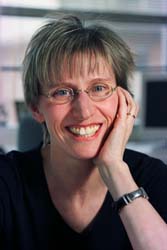New technique dissects stem cells’ picky likes, dislikes
Whether their goal is to create therapies or simply investigate how organisms develop, stem cell researchers face what is perhaps one of biological science's toughest assignments: keeping their tiny research subjects under control.
Stem cells have notoriously finicky tastes, and despite a decade of advances, researchers are still honing the conditions under which the cells will continue dividing indefinitely in culture or begin morphing into specific cell types.
“The question is ‘What are the exact signals that are required to keep stem cells in an undifferentiated state?’. It’s a complicated problem, but when you distill it down, these are all just molecules. So, that’s where chemists can make a difference.”
Laura Kiessling, professor of chemistry
University of Wisconsin–Madison research led by chemistry professor Laura Kiessling now offers these scientists a new tool. Writing in the May 4 online edition of ACS Chemical Biology, Kiessling and her colleagues describe a system that can quickly and systemically screen hundreds of individual molecules for their ability to influence stem cell fates.
Harvesting the scientific and therapeutic promise of stem cells hinges on establishing precise and reproducible conditions for growing them, says Kiessling. Although great strides have been made in this area, scientists are still searching for factors that will boost stem cell growth rates, for example, or cut the number of cells that spontaneously transform, or "differentiate," into unwanted cell types.
As a means to quickly identify specific molecules that might produce these and other effects, the technique could hasten efforts to develop stem cell therapies and attain new insights in developmental biology, says Kiessling. Moreover, her team's chemistry-based technique not only allows scientists to test molecules from nature, but synthetic ones, as well.
"One provocative possibility is that if you deliver non-natural signals to these cells maybe you can get a greater diversity of responses than if you just use biological signals," says Kiessling.
Inside living organisms, stem cells nestle within the "stem cell niche," a microenvironment in which they bump against the surfaces of other cells, as well as adhere to a substrate called the extracellular matrix (ECM). These interactions with surfaces play a key role in stem cell growth and differentiation. And that got Kiessling thinking.
"If we want to control stem cell fates," she says, "maybe we could start to create surfaces of defined molecules, put stem cells down on them, and ask, 'What happens?'"
To this end, the researchers tethered 18 distinct protein fragments, known as peptides, to the surfaces of specially treated microscope slides. The peptides were arranged in a regular pattern of squares, each measuring one-half to three-quarters of a millimeter on a side.

Kiessling
Patterns of DNA and proteins on surfaces, known as arrays, are common tools in biological research. What sets Kiessling's arrays apart is the size and function of the square-shaped patches of peptides: They're roomy enough to let stem cells grow in them for up to a week, yet tiny enough to allow screening of hundreds of different conditions within a single square inch.
The peptides her team chose to test first come from a major protein component of the ECM called laminin. Laminin also makes up about 60 percent of Matrigel, an extract from mouse cells that often serves as a substrate for growing stem cells in culture.
In a series of weeklong experiments, the team placed human embryonic stem (ES) cells onto the squares in the arrays, set the arrays in a culture plate and added a culture medium on top. What they found is that five of the 18 surfaces – each displaying just a single peptide from laminin – did as well as the mixture Matrigel at growing human ES cells in their "blank slate," undifferentiated condition.
The researchers don't yet know why these particular laminin peptides promote human ES cell growth. But with them in hand, scientists can now take the next step of identifying the receptors or other molecules that the peptides are targeting, says Kiessling.
"The question is 'What are the exact signals that are required to keep stem cells in an undifferentiated state?" she says. "It's a complicated problem, but when you distill it down, these are all just molecules. So, that's where chemists can make a difference."
The paper's other authors are UW–Madison chemistry graduate students Ratmir Derda and Lingyin Li, stem cell biologists James Thomson and Rachel Lewis, and Brendan Orner of Nanyang Technological University.
Tags: biosciences, business, chemistry, research




